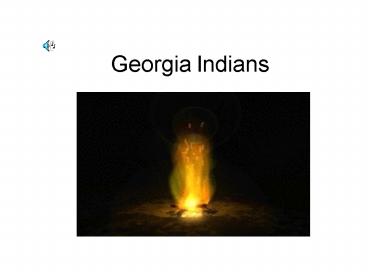Georgia Indians PowerPoint PPT Presentation
1 / 29
Title: Georgia Indians
1
Georgia Indians
2
Paleolithic Period20,000BC to 8,000BC
- Early 20,000 BC to 13,000 BC
- Highly-mobile nomadic hunters who use stone to
make crude tools and weapons - Late 13,000BC to 8,000BC
- Some gathering occurs. Occupation of areas may be
seasonal.
3
Migration Theory
4
Oral Traditions
- According to their oral tradition, they
originated in North America and did not migrate
from somewhere else.
5
Archaic Period8,000BC to 1,000BC
- Start of sustained agriculture.
6
Woodland 2,000 BC to 1,000AD
7
Moundbuilder Period 2,500 BC to 1,560AD
- This unique cultural development arose in
northeast Louisiana during the late Archaic era,
spreading inland along the Mississippi-Missouri-Oh
io River complex.
8
Georgias Ancient City
9
Creek Nation1500 to 1836
- Oral Tradition The Creeks migrated from the
west from Mississippi to present-day Alabama and
Georgia. - Creeks are thought to have descended from the
Mississippian Moundbuilders. - Common culture and language are similar to the
Seminole.
10
Creek Confederacy
- Confederacy of about 12 independent tribes in
Georgia - The largest tribe in the Creek world were the
Muskogee (Muscogee).
11
Cherokee 1450 to 1838
- For 400 years the Cherokee not only ruled
present-day north Georgia, but significant areas
of North and South Carolina, Tennessee, Alabama,
Kentucky and Ohio
12
Cherokee Oral Tradition
- Oral Tradition Cherokee migrate from the north.
- Oral Tradition Cherokee are a south branch of
the Iroquois. - Language similar to Iroquois
13
BATTLE OF TALIWA
- Two and one-half miles to the east, near the
confluence of Long-Swamp Creek and the Etowah
River, is the traditional site of Taliwa, scene
of the fiercest and most decisive battle in the
long war of the 1740's and 50's between the
Cherokee and Creek Indians. - There, about 1755, the great Cherokee war-chief,
Oconostota, led 500 of his warriors to victory
over a larger band of Creeks. So complete was the
defeat that the Creeks retreated south of the
Chattahoochee River, leaving to their opponents
the region later to become the heart of the
ill-fated Cherokee Nation. - 028-1 GEORGIA HISTORICAL COMMISSION 1953
14
Land Cessions to the White Man
- 1733 First Creek Cession to James Oglethorpe.
Established Savannah, GA - 1763 Treaty of Augusta. Defined line between
Creeks and Georgia Colony.
15
1773 Land Cession
- Creek and Cherokee Cessions to pay traders for
debts owned.
16
1782-1783 Land Cession
- Land to south and west of Tugaloo and Savannah
Rivers ceded by Creeks and Cherokee. Both claimed
ownership to land.
17
1790 Land Cession
- 1790 Treaty of New York. Upper Creek land ceded
from Altamaha to Oconee Rivers.
18
Georgias Western Land Claims
- 1802, Georgia gave up its western land claims to
Mississippi River to federal government. - Federal government promised to remove Indians
from Georgia.
19
William McIntosh
- Leader of the Creek Nation
- Mixed-blood son of a Scottish trader and Creek
mother - Fought in the Creek Wars and the Seminole War
- Signer of 1825 Treaty of Indian Springs
20
Creek Indian Trail of Tears
- Creeks removed to Indian Territory by 1827.
- An estimated 3,500 Creeks died in Alabama and on
their westward journey to Indian Territory.
21
Federal Indian Removal Policy
- In 1830 it was endorsed, when Congress passed the
Indian Removal Act to force those remaining to
move west of the Mississippi.
22
Cherokee Nation in Conflict
- Mixed-blooded Cherokee wanted to remove to Indian
Territory. - Full-blooded Cherokee wanted to remain east of
Mississippi River.
23
Cherokee Court Case
- The Cherokees successfully challenged Georgia in
the U.S. Supreme Court. President Jackson, when
hearing of the Court's decision, reportedly said,
"Chief Justice John Marshall has made his
decision let him enforce it now if he can.
24
The Treaty of New Echota
- In December 1835, the U.S. sought out this
minority to effect a treaty at New Echota,
Georgia. Only 300 to 500 Cherokees were there
none were elected officials of the Cherokee
Nation. Twenty signed the treaty, ceding all
Cherokee territory east of the Mississippi to the
U.S., in exchange for 5 million and new
homelands in Indian Territory.
25
Forced Removal
- Chief John Ross fought for the Cherokee to remain
on their lands. - In the Spring of 1838, the Cherokee were rounded
up and marched up the Federal Road to Tennessee.
26
Fort Buffington
- One-half mile north is the site of Fort
Buffington, - built in the 1830's by local militia. It was one
of - about 25 stockades in the Cherokee Indian Nation
- used by Federal and State troops during the
- Cherokee Removal in 1838. In May and June, 1838,
- 7,000 soldiers forced over 15,000 Cherokee
Indians - from their homes and held them in the stockades
- until removal west could take place. Many Indians
- from the local area were held at Fort Buffington.
- As many as 4,000 Cherokees may have died
- while in the stockades and on the 800 mile
- journey west. Their ordeal has become known
- as the "Trail of Tears."
- 028-6 GEORGIA HISTORICAL MARKER 1992
27
Cherokee Routes to Indian Territory
28
Cherokee Nation
29
Today in GEORGIA
- Cane Break Band of E. Cherokees
- Cherokees of Georgia, Inc., petitioned 1/9/79
- Georgia Tribe of E. Cherokees, petitioned 8/8/77
- Lower Muskogee Creek Tribe- E. of the
Mississippi, petitioned 2/2/72 acknowledgement
declined, 12/21/81 - Southeastern Cherokee Confederacy, Inc.,
petitioned 3/9/78

